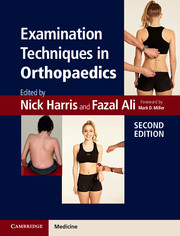Book contents
- Frontmatter
- Dedication
- Contents
- List of contributors
- Foreword
- Preface
- Acknowledgements
- 1 General principles of orthopaedic clinical examination
- 2 Examination of the shoulder
- 3 Examination of the elbow
- 4 Examination of the wrist
- 5 Examination of the hand
- 6 Examination of the peripheral nerves in the hand and upper limb
- 7 Examination of the adult spine
- 8 Examination of the hip
- 9 Examination of the knee
- 10 Examination of the foot and ankle
- 11 Examination of the brachial plexus
- 12 Orthopaedic examination techniques in children
- 13 Examination of the spine in childhood
- Index
- References
7 - Examination of the adult spine
- Frontmatter
- Dedication
- Contents
- List of contributors
- Foreword
- Preface
- Acknowledgements
- 1 General principles of orthopaedic clinical examination
- 2 Examination of the shoulder
- 3 Examination of the elbow
- 4 Examination of the wrist
- 5 Examination of the hand
- 6 Examination of the peripheral nerves in the hand and upper limb
- 7 Examination of the adult spine
- 8 Examination of the hip
- 9 Examination of the knee
- 10 Examination of the foot and ankle
- 11 Examination of the brachial plexus
- 12 Orthopaedic examination techniques in children
- 13 Examination of the spine in childhood
- Index
- References
Summary
History
General history
The majority of adult patients with problems of spinal origin present with complaints of pain in the back and/or legs, with a resultant loss of function.
It is, therefore, as important to understand and record the impact of the perceived pain on the daily work and recreational activities of the patient as it is to enquire about the nature of the pain itself.
One should begin with the patient’s occupation, social circumstances (e.g. young children at home, carer for elderly relative, living alone) and sporting activities. Then enquire about the limitations on all of these aspects of daily living with particular reference to days taken off work, time periods of relative immobility and problems coping with household duties. Specific disability scoring systems can be used if wished. The patient’s age should always be used to help steer thoughts toward a likely diagnosis. Never accept a diagnosis of mechanical back pain in patients outside the age range of 20–55 years without thorough investigation, particularly in the presence of non-mechanical or other atypical symptoms.
- Type
- Chapter
- Information
- Examination Techniques in Orthopaedics , pp. 85 - 102Publisher: Cambridge University PressPrint publication year: 2014
References
- 1
- Cited by



